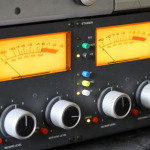 A few days ago I received a new rock song to mix. Downloaded and unpacked everything, fired up Pro Tools and imported all the tracks, as always… That was the moment when I noticed how huge that tracks count was.
A few days ago I received a new rock song to mix. Downloaded and unpacked everything, fired up Pro Tools and imported all the tracks, as always… That was the moment when I noticed how huge that tracks count was.
There were about 70 tracks!
It’s a big session to deal with. To my personal standards, that is a serious figure.
So I told myself: ”All right Fab, you need to mix this…and you need to do that within a certain amount of time… and you need to do it right. The final mix will have to sound great!”
I realized some strategy was needed in order to reach my goad while keeping some sanity.
That’s exactly what I want to write about today: I want to tell you the process that made me possible to mix all of that stuff with no pain.
In the end, everything went way beyond all of my expectations! I knew it’d have worked, but not so well…
I actually ended up spending less than 4 hours for the entire mixing of this huge song!
I mean, after that amount of time the mix was finished, the song was ready to go. No joke!
How was it possible? Here it is!
Step #1) Your Virtual Working Environment
Your DAW should serve you, not vice versa. It should let you work flawlessly, otherwise you’ll be a slave of your computer and won’t churn out a great song. Period.
You need to create a comfortable working environment within your computer, a tidy and uncluttered workspace that can free you from searching tracks around.
To do so, seek and select all the drum tracks, group them all together in the same place and rename them in a way that’s easy to understand, then apply some color to the channels. Rinse and repeat for bass, guitars, synths, vocals, backing vocals… Color coding is super important, as it will let you instantly recognize the different instruments within all the tracks by their unique color!
At the end of this single 5 minutes process, you’ll feel way less stressed and everything will be at least more “workable”.
Create your own personal workspace setup and stick to that for every new session starting from now.
Step #2) First Listen
This is a crucial step. It happens only once with each song: the very first time you listen to it.
Why do I think it’s important? Because it’ll give you some precious clues about the direction you need to follow with your mix!
Just hit play, close you eyes and listen to the song. Make some mental notes about what you’re hearing: that epic chorus, that exciting guitar solo, that weak toms fill…
Then listen to it again, but this time write down some notes while the mix is playing. Use a simple sketchpad or notebook and write things like: “the verses need a lift…that snare is awesome! It deserves a spotlight…”. Try to get the feel, the vibe of the song.
A big part of mixing is based on creativity and feelings, so try to understand what the song is telling you and put yourself in the right mood.
Step #3) Proper Gain Staging
What is “gain staging”? These 2 words may cause some confusion but the matter is simple. When you’re mixing, there are many tracks playing at the same time, from the kick to the very last background harmony, right? All these tracks are going summed into one single virtual channel: the master bus. Having too much “digital informations” coming into a single master channel will cause overloading, clipping, nasty digital distortion. In other words: nothing good!
If you haven’t already, check out my eBook “The Recording Roadmap”. There you’ll find some useful guidelines on how to deal with gain staging and recording levels.
You can download it for FREE right now. Don’t miss it!
In essence: you should avoid to crowd the master bus and keep conservative levels within your session. Simply make sure things are not too hot while reaching the mix buss. If I notice the tracks I’m mixing have been recorded too hot, I make use of a simple gain trimming plugin to lower the level of each track enough to get a good conservative level on the master channel, about 60% to 70% should be fine, keeping it within the yellow region. No reds allowed.
Step #4) Do A Static Mix And Then Go Away
I usually do my static mixes with a timer set to 10 minutes, but that’s for smaller sessions. Considering the high number of tracks, this time I decided to set the timer to 15 minutes, just to leave me some space to breathe.
Leave all the channels to their starting level and hit play.
At this stage you need to aim for the “perfect balance” between tracks using just the volume faders and pan pots. Force yourself to mix as a “live guy”, with the band playing live in front of an audience. Try to really get the best you can out of it.
Working this way you’ll focus your sight on important things only.
Once done, record this rough mix on a separate stereo track to keep a copy of it, then close your DAW and go away…
Doing so will help you approach the song with a “fresh” mindset the next day!
Step #5) Set Your Interface To Mono And Forget About It
Yes, force yourself to work in Mono. Especially when you need to deal with loads of tracks, that will be a huge time saver and will make your work a lot easier. So, after the first static mix in Stereo (you can even do that in Mono, indeed), set your DAW or your interface to Mono and work that way.
While working in Mono you can’t hear all the wide stereo field, of course, but you can hear tracks that are fighting each other for a certain frequency range and then act with tools like EQ and compression to make everything work!
This thing will really speed up your work and, if you’ll be able to make it sound good with all the tracks collapsed into a claustrophibic Mono tunnel, it will literally sound amazing when you’ll get back to Stereo.
Step #6) 2-Buss Processing
If you want to apply some kind of processing on the entire mix (i.e. on the master channel) that’s the right time to think about it. The purpose of this thing is to give your entire track some glue, cohesion or color, without dramatically changing the tone. You just need to have all of this stuff set right from the start to make it work.
You can then make some changes later if the song needs them…
Step #7) Create Subgroups And Work On Them First
The worst thing you can do now is to start tweaking knobs jumping from track to track. It gets even worse if you do that while listening to each track in solo!
Start by creating some subgroups: a bus for drums, one for guitars, one for synths; you get the idea. Don’t forget to apply some color coding to them as well. The same color for each bus track should be fine, you just need to set them apart from anything else.
Then work on faders again. Don’t set them in a “more or less is here” position, don’t rush! Just volume faders and pan pots.
Now, start working on the busses only. I started with the drums ‘cause I felt that was a good idea, but you can start with the instrument you want to, according to the song.
The idea here is to craft a good sound without too much processing. Most of the times, some simple EQ and compression moves will take you very far with not so much efforts.
At the end of this stage, you should have a solid initial mix coming out of your speakers. You should feel comfortable of playing it to one of your friends.
Step #8) Individual Tracks Processing
Even after some work on levels and busses is not unusual to hear something sound a bit off. Some tracks get buried while some others are sticking out too much. It’s ok…
If you’ve done all your homeworks with the previous step, now (and now only) you can consider the idea of processing individual tracks with some plugins.
There were loads of guitar tracks in this specific song, both with different phrases and overdubs…
A thing I’ve done to make it work without getting crazy has been to make use of what’s called “Complementary EQ”. In a few words, the key of this EQ technique is to boost a specific frequency on guitar A while cutting the same frequency on guitar B, freeing some space to let each track sing out and be heard. Remove the bad to hear the good!
Use as few plugins as you can. You should aim to get a great result using only EQ and compression.
Keep working in Mono throughout all this process.
Step #9) Back To Stereo
Now it’s time to get back to Stereo and put some spices on the track; things like reverbs and delays.
With this song, I chose to set 3 different reverbs: one specific for the snare (it really needed it), one for the vocals (and for some guitar parts) and one on for the entire mix, on the master bus. Crazy? Maybe. But it sounded great! I then added a pair of delay channels and sent some vocals and guitars to them to give them some depth and color. Just keep it simple.
Choose your cup of tea but don’t get mad with it! Keep yourself on the rails. Set it, listen and make some minor changes to the mix balance if needed.
After that, close your session and get back to your life. It’s not over, not yet, but your ears are tired now. This is the only exception where you can delay other decision to days to come.
Step #10) The Next Day
Reopen the session the very next day or a few days later and check it again with fresh ears, eventually fixing something here and there.
Don’t spend too much time on this (1 hour and 30 minutes max) and, most important, spend time getting actual things better, not changing things! Our brain, after a long lasting working session listening to the same program, tends to perceive as better every little thing that’s just… different!
While you’re looking for cohesion, emotions and things like that, you’ll only get different sounds and textures not related with each other within the same song. You’ll loose the direction for your song…
I proved it on my skin: you’ll never get to the finish line if you start changing stuff.
Listen to the song at low volumes, maybe while checking your inbox or whatever, trying to notice if something is annoying you somehow.
Another good idea would be to listen to the song on other devices, from your mp3 player to the Hi-Fi in your living room…
In my case, I worked a bit more on the snare and changed the reverb time just a little, then everything sounded just good, so why keep tweaking things?
Final Thoughts
I’m a very methodical guy. I can’t work at my best if I don’t have some kind of roadmap to follow. That’s why I use a variation of this strategy on every single song I mix. I am addicted to it! Despite this, I got a really nice surprise this time. It happened other times in the past, but it keeps astonishing me at each round…
I’ve been able to mix this song in less than 4 hours, total time, start to finish!
If we consider the high number of tracks involved, that’s a pretty big result. And let me tell you: it sounded even better than some of my previous mixes on which I spent loads of hours!
What’s really important is that’s not because I am super-duper-ninja-good at mixing! NO.
It’s because I used a strategy! The same killer methodic strategy you just finished reading made this possible.
Having a clear goal in mind of what you want to accomplish starting with the first listen and then move on using some proven guidelines is all you really need to take your mixes to the next level, in less time, with less frustration and more creativity and fun in the process.
Please, try to adopt this strategy starting from your next mix!
Change it a bit to suit your habits and create your own personal plan if you believe but, after that, commit to it! Use it on every session. You can only get good things out of it!
Are you going to try this thing out?
Or perhaps this is already part of your workflow? Share your killer plan in the comments…


![Printing Virtual Instruments To Track [Reader’s Question]](http://www.recording64.com/wp-content/uploads/2014/07/mini_grand-150x150.jpg)


